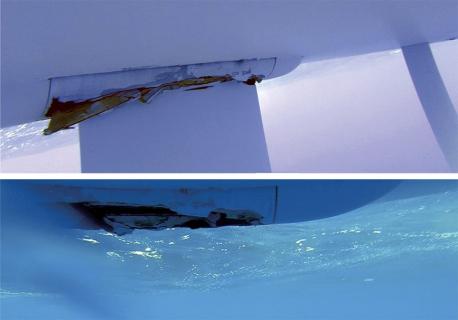New Safety Regulation Highlights Keel Security
CCA Safety Moment, Sally Honey, 12 January 2022
As many of you know, there is a long-standing problem with keel and rudder breakage causing both loss of vessels and of sailor’s lives. My partial, incomplete count lists 93 keels lost since Chuck’s experience with Charley in 1983, resulting in 29 lives lost.
Stan started a project at the World Sailing Oceanic & Offshore & Special Regulations Subcommittees to combat this troubling trend which is continuing. There is an update that has been proposed to the ISO 12215-9, which would increase the build strength of keel appendages by a factor of 2. This is still in process, and we hope will have a positive result by this summer.
Meanwhile, WS’s Offshore Special Regulations committee has developed a new requirement effective January 1, 2022, for Cat 0-3 race boat owners to arrange for a qualified person to inspect their keel and rudder at least every two years and after any unintentional grounding. Several MNAs have developed detailed forms to help owners meet this new requirement.
US sailors are not bound by the OSRs and this is therefore NOT a requirement under US SERs, but it is good seamanship to periodically inspect your keel and rudder. It is therefore appropriate for a brief review of the OSR 3.02 requirement and Appendix L recommendations:
Mo0,1,2,3 3.02.2 Effective 1 January 2022: Structural Inspection - Consult the owner’s manual for any instructions for keel bolt checking and re-tightening. The inspection to be conducted by a qualified person externally with the boat out of the water. Check that there are no visible stress cracks particularly around the keel, hull/keel attachment, hull appendages and other stress points, inside the hull, backing plates, bolting arrangements and keel floors. (See Appendix L - Model Keel and Rudder Inspection Procedure)
Mo0,1,2,3 3.02.3 Effective 1 January 2022: Evidence of a structural inspection in accordance with 3.02.2 within 24 months before the start of the race or after a grounding whichever is the later
Mo0,1,2,3 3.02.4 Effective 1 January 2022: Inspection after Grounding – an appropriately qualified person shall conduct an internal and external inspection after each unintentional grounding
Appendix L - Model Keel and Rudder Inspection Procedure – Main points:
- Model Form: not the only way to provide Evidence of Periodic Structural Inspection, OA may develop on-line forms.
- shall be completed by “a qualified person” both internally and externally (out of water). Owner responsible to make repairs
- consult Owners’ Manual for the specific boat, steering system and type of keel. Inspect high-load areas, pay attention to prior repairs.
- Internally, check backing plates, bolting arrangements, sump area and keel floors for any signs of cracking, weakening, or de-laminated tabbing; tighten bolts, inspect for corrosion, “ovaling” of bolt holes, de-bonding of support structure.
- External stress cracks or movement at keel/hull interface, keel tip deflection, high stress areas at forward/ aft hull attachment areas, large deep blisters, which can indicate separation.
- Rudder/Steering system – bearing area damage/cracks? Shaft & blade integrity? Tip deflection? Corrosion or cracking of rudder straps and gudgeons, if applicable.
- Lifting and swing keels: no significant stress cracks in structure around pins supporting the keel. Check for extensive corrosion on pins, cylinders and supporting metal structure.
For all -Finally, as an owner, arrange to inspect your keel and rudder whenever boat is hanging in slings:
Wiggle/wobble test (Glen’s video) of both keel and rudder, especially after grounding
Observe any lingering dampness/weeping after a haul out – sign of internal structural issue. If your rudder has a metal shaft, be particularly sensitive to lingering dampness where the shaft exits the rudder blade.
Be aware of any problems with the same/similar designs, which may indicate consistent problems with particular class, design or builder.
Finally, it is your responsibility and only prudent to take every opportunity to make sure your underwater appendages are as structurally sound as those you see every day.
For further review:
OSR 2022-24: https://www.sailing.org/tools/documents/WSOffshoreSpecialRegulations20222023v2-[27823].pdf See 3.02 for new keel inspection requirement
Appendix L: https://www.sailing.org/tools/documents/OSR2020AppL17122020-[26845].pdf
Video demonstrating keel inspection: https://fb.watch/8Sy7bYd5_x/
Ran Tan keel loss: 13 year old canting keel. Too many cycles
During and after separation.





